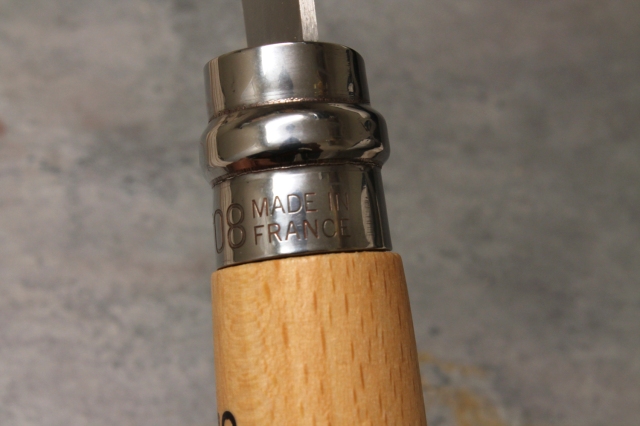 I had seen Opinel Knives in advertisements and magazine articles for decades. It was not until a trip to the New York Museum of Modern Art a few years ago that I actually saw the “peasant knife” in person. Two weeks ago, I had another New York City brush with the Opinel as I was able to handle several in a cutlery store. Right away, I purchased an Opinel No. 8 for fifteen dollars to bring home in my checked luggage.
I had seen Opinel Knives in advertisements and magazine articles for decades. It was not until a trip to the New York Museum of Modern Art a few years ago that I actually saw the “peasant knife” in person. Two weeks ago, I had another New York City brush with the Opinel as I was able to handle several in a cutlery store. Right away, I purchased an Opinel No. 8 for fifteen dollars to bring home in my checked luggage.
Joseph Opinel invented his simple folding knife in 1890. A savvy toolmaker, Opinel wanted the knife to feel comfortable in the hand and pocket, thus the timeless shape of the Beechwood handle was born. By 1897, the line of knives had grown to 12 sizes. French factories would be built and mass production of the Opinel knives would begin shortly thereafter.
The classic Opinel knife consists of only five simple components: its blade, pivot pin, clamping ring, safety ring, and handle. In 1955, the Virobloc safety ring was added to make the Opinel lock open securely. The safety ring was again modified in 2000 to lock the blade closed. The entire knife weighs 1.6 ounces.

 Current high carbon steel used in the Opinel blade is XC90, equivalent to 1086 tool steel. It can hold a great edge and looks fantastic with either natural or owner-applied patina. Leaving a carbon No. 8 stabbed into an onion for half a day will give the XC90 steel a darkened patina pattern that will help resist normal corrosion. I decided to buy my No. 8 with Opinel’s Inox stainless steel, which is Sandvik 12c27 MOD. Inox is French for inoxydable or stainless.
Current high carbon steel used in the Opinel blade is XC90, equivalent to 1086 tool steel. It can hold a great edge and looks fantastic with either natural or owner-applied patina. Leaving a carbon No. 8 stabbed into an onion for half a day will give the XC90 steel a darkened patina pattern that will help resist normal corrosion. I decided to buy my No. 8 with Opinel’s Inox stainless steel, which is Sandvik 12c27 MOD. Inox is French for inoxydable or stainless.
The Opinel No. 8’s 3 1/4″ clip point blade is full flat ground to a near zero edge. There is just the slightest perceptible secondary bevel. My knife came right at shaving sharp. It is an excellent cutter. After slicing a bale of cardboard and plastic strapping, the No. 8 would still thinly slice a tomato for my sandwich.

 Because of its rudimentary construction, an Opinel comes with tight tolerances from the factory. Although the clamping ring holds the blade very firmly in the wood handle, the opening action of the blade will loosen somewhat with use. Similarly, the safety ring may initially take some effort to turn.
Because of its rudimentary construction, an Opinel comes with tight tolerances from the factory. Although the clamping ring holds the blade very firmly in the wood handle, the opening action of the blade will loosen somewhat with use. Similarly, the safety ring may initially take some effort to turn.
When I made my lunch today, I rinsed the Opinel at the sink to get the food residue off of it. The Beechwood became swollen with water, so the knife will be a little stiff until the wood settles back down and dries. That is normal. You can Internet search waterproofing an Opinel–it usually involves stripping the factory finish from the handles and applying a hydrophobic agent. I will leave my handles as they are.


 I love tacticool things as much as the next operator, but some products endure unchanged throughout generations because of their grand form, fit, and function. This is one such item. As a workingman’s folding knife, the Opinel No. 8 is a superlative tool. I love the Old World look and feel of the knife. Its design made a place for it in the New York MOMA and that is high praise for a 123 year-old shape.
I love tacticool things as much as the next operator, but some products endure unchanged throughout generations because of their grand form, fit, and function. This is one such item. As a workingman’s folding knife, the Opinel No. 8 is a superlative tool. I love the Old World look and feel of the knife. Its design made a place for it in the New York MOMA and that is high praise for a 123 year-old shape.
by Wilson

Opinel is the best folding knife. Simple, it’s smooth and genuine. I have the number 8 and 9.
LikeLike
I have and sold quite a few Opinel 12 knives! I really like them I was skeptical when I first seen and bought one but was impressed and since I sell hives I thought Iwould pick up a few more to see if they would sell. it seems others like them also. They make a great knife to keep in your tackle box of fishing along with many other uses,
LikeLike
Pingback: » 10 Eye-Catching Folding Hunting Knives
Pingback: 10 Eye-Catching Folding Hunting Knives - Modern Survival Living
Pingback: 10 Eye-Catching Folding Hunting Knives
Pingback: » 13 Eye-Catching Folding Hunting Knives